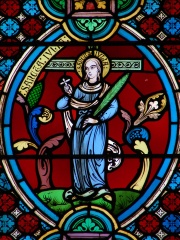



The Most Famous
RELIGIOUS FIGURES from Tunisia
This page contains a list of the greatest Tunisian Religious Figures. The pantheon dataset contains 3,187 Religious Figures, 5 of which were born in Tunisia. This makes Tunisia the birth place of the 62nd most number of Religious Figures behind Colombia, and Nepal.
Top 5
The following people are considered by Pantheon to be the most legendary Tunisian Religious Figures of all time. This list of famous Tunisian Religious Figures is sorted by HPI (Historical Popularity Index), a metric that aggregates information on a biography's online popularity.

1. Cyprian (200 - 258)
With an HPI of 76.90, Cyprian is the most famous Tunisian Religious Figure. His biography has been translated into 52 different languages on wikipedia.
Cyprian (; Latin: Thascius Caecilius Cyprianus; c. 210 to 14 September 258 AD) was a bishop of Carthage and an early Christian writer of Berber descent, many of whose Latin works are extant. He is recognized as a saint in the Western and Eastern churches. He was born around the beginning of the 3rd century in North Africa, perhaps at Carthage, where he received a classical education. Soon after converting to Christianity, he became a bishop in 249. A controversial figure during his lifetime, his strong pastoral skills, firm conduct during the Novatianist controversy and outbreak of the Plague of Cyprian (named for his description of it), and eventual martyrdom at Carthage established his reputation and proved his sanctity in the eyes of the Church. His skilful Latin rhetoric led to his being considered the pre-eminent Latin writer of Western Christianity until Jerome and Augustine.

2. Fatima al-Fihri (800 - 880)
With an HPI of 74.98, Fatima al-Fihri is the 2nd most famous Tunisian Religious Figure. Her biography has been translated into 38 different languages.
Fatima bint Muhammad al-Fihriya al-Qurashiyya (Arabic: فاطمة بنت محمد الفهرية القرشية), known in shorter form as Fatima al-Fihriya or Fatima al-Fihri, was an Arab woman who is credited with founding the al-Qarawiyyin Mosque in 857–859 CE in Fez, Morocco. She is also known as Umm al-Banīn ("Mother of the Children"). Al-Fihriya died around 880 CE. The al-Qarawiyyin Mosque subsequently developed into a teaching institution, which became the modern University of al-Qarawiyyin in 1963. Her story is told by Ibn Abi Zar' (d. between 1310 and 1320) in The Garden of Pages (Rawd al-Qirtas) as founder of the mosque. Since she was first mentioned many centuries after her death, her story has been hard to substantiate and some modern historians doubt her existence.

3. Julia of Corsica (420 - 450)
With an HPI of 69.83, Julia of Corsica is the 3rd most famous Tunisian Religious Figure. Her biography has been translated into 19 different languages.
Julia of Corsica (Italian: Giulia di Corsica; French: Julie; Corsican: Ghjulia; Latin: Iulia), also known as Julia of Carthage, and more rarely Julia of Nonza, was a virgin and martyr who is venerated as a saint. Her death occurred most probably in AD 439 or thereafter. She and Devota are the patron saints of Corsica in the Catholic Church. Julia was declared a patroness of Corsica by the church on 5 August 1809; Devota, on 14 March 1820. Both were martyred in pre-Christian Corsica under Roman rule. Julia's feast day is 23 May in the Western liturgical calendar and 16 July in the East. Julia is included in most summary lives of the saints. The details of those lives vary, but a few basic accounts emerge, portraying biographical data and events that are not reconcilable. Various theories accounting for the differences have been proposed. The quintessential icon of Saint Julia derives from the testimony of Victor Vitensis, contemporaneous Bishop of Africa. It is supported by physical evidence: the relics, a small collection of human bone fragments, are where historical events subsequent to the story say they ought to be, at the former Church of Santa Giulia in Brescia, Italy, now part of the city museum.

4. Fulgentius of Ruspe (468 - 533)
With an HPI of 64.74, Fulgentius of Ruspe is the 4th most famous Tunisian Religious Figure. His biography has been translated into 25 different languages.
Fabius Claudius Gordianus Fulgentius, also known as Fulgentius of Ruspe (462 or 467 – 1 January 527 or 533), was a North African Christian prelate who served as Bishop of Ruspe in what is now Tunisia, during the 5th and 6th century. He is venerated as a saint.

5. Youssef Rzouga (b. 1957)
With an HPI of 53.76, Youssef Rzouga is the 5th most famous Tunisian Religious Figure. His biography has been translated into 17 different languages.
Youssef Rzouga is a Tunisian writer and poet, born on March 21, 1957 in Zorda, Tunisia. He began writing in 1967. His first published text was "Something called need," a short story in the magazine Radio et Télévision (1973).
People
Pantheon has 5 people classified as Tunisian religious figures born between 200 and 1957. Of these 5, 1 (20.00%) of them are still alive today. The most famous living Tunisian religious figures include Youssef Rzouga. The most famous deceased Tunisian religious figures include Cyprian, Fatima al-Fihri, and Julia of Corsica.
Living Tunisian Religious Figures
Go to all RankingsDeceased Tunisian Religious Figures
Go to all RankingsCyprian
200 - 258
HPI: 76.90
Fatima al-Fihri
800 - 880
HPI: 74.98
Julia of Corsica
420 - 450
HPI: 69.83
Fulgentius of Ruspe
468 - 533
HPI: 64.74

